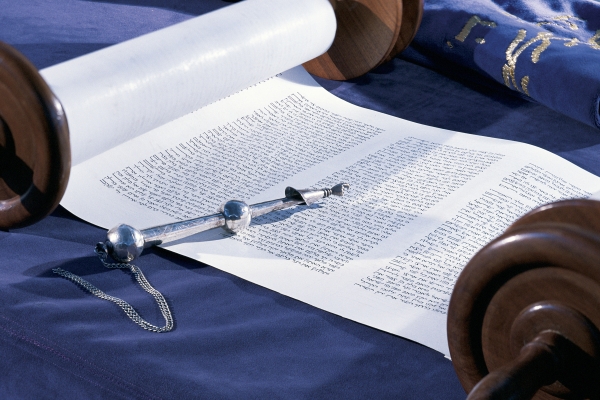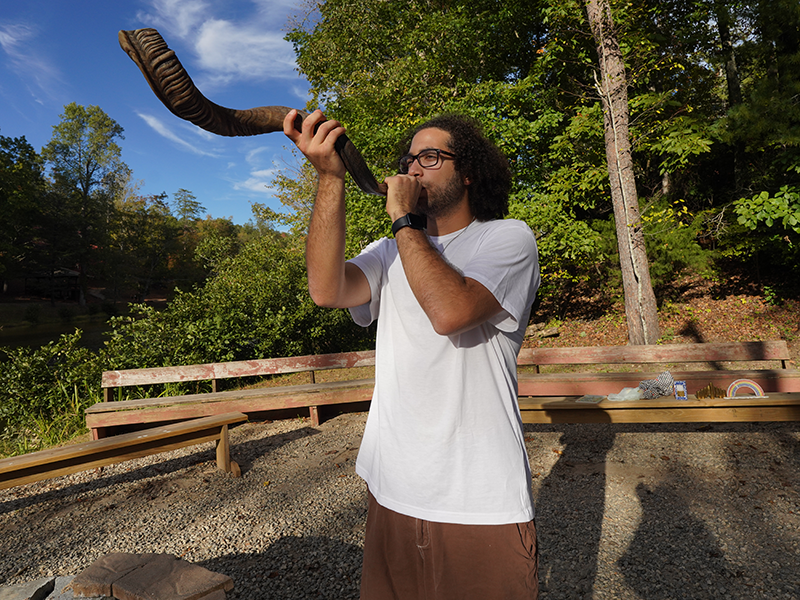If we were to compare the Book of Exodus to a “rock” (as in Mt. Sinai) and the Book of Numbers to a “hard place” (as in the “wilderness”), then the Book of Leviticus would be somewhere “between a rock and a hard place.” My sense is that for most Reform Jews, reading the third book of the Torah, Leviticus, is more a function of calendar than choice: a tough, unavoidable literary landscape with only a few rest stops or scenic overlooks. It’s just a territory we must traverse in order to get to the next major site on our annual pilgrimage through the Five Books of Moses.
We are hardly alone in our relationship with the Book of Leviticus. In 1982, Reader’s Digest published a condensed version of the Revised Standard Version of the Bible, edited by Bruce M. Metzger, a New Testament scholar at Princeton Theological Seminary. Not surprisingly, Hebrew Scripture in general was condensed by Reader’s Digest more than the books of the New Testament, and the Book of Leviticus was compressed the most into just a few pages! Except for its key ethical passages, Leviticus was clearly a spiritual challenge to Prof. Metzger and his editorial team. American religious modernists it would seem, Jewish and non-Jewish, just do not gravitate toward the spirituality of an ancient priestly cult, its sacrifices, garments, and premodern medical practices.
For today’s Reform Jews, the Book of Leviticus — including its first portion — Vayikra — is a spiritual challenge, although we seem to prefer a select reading of the whole book to a condensed version. Our movement’s massive and illuminating modern commentary (1981; rev., 2005) to the Torah treats Leviticus in a fashion completely equal to the other four books of the Pentateuch. Anecdotally, it seems that synagogue-based parashat hashavuah (weekly portion) groups do not change their curriculum or methodology when they encounter Leviticus on an annual basis. Our b’nei mitzvah also are regularly assigned portions from Leviticus in order and without substitution. Of course, some families dread the idea of their children having to study the diagnosis and treatment of leprosy for months on end before their b’nei mitzvah, but are still willing for them to learn to vocalize the Hebrew text and find an apt modern, medical metaphor for skin disease for their divrei Torah. On the afternoon of Yom Kippur, Reform Judaism has stayed with Leviticus although it did shift the Torah reading by one portion to Leviticus 19. And on the morning of Yom Kippur, we substitute the uplifting report of Moses’ ceremony on covenantal renewal in Nitzavim (Deuteronomy 29:9-14) for the ancient ritual of the scapegoat (Leviticus 16). (However, the new Reform machzor, Mishkan HaNefesh, 2015, includes the option of reading a section of Leviticus 16 on Yom Kippur afternoon.)
Deep down, much of Leviticus remains a problem for most Reform Jews today. Given the history of Leviticus in Reform Judaism, our aversion to much of the Torah’s third book should not be a surprise. First, early in its development Reform Judaism openly repudiated Ancient Israel’s priestly tradition. In no uncertain terms, Reform Judaism rejected the idea of a dynastic priesthood, the practice of sacrifice, and the belief in the restoration of the Temple cult. Despite the various efforts of neo-Reformers to reclaim “tradition” for Reform Judaism, beginning with the 1937 Columbus Platform, the rejection of the Levitical tradition among Reform Jews has remained virtually complete. In this sense, we are truly “reformed,” not Reform Jews.
At the first conference of Reform Rabbis in America held in Philadelphia in 1869, three of the meeting’s seven resolutions focused specifically on the place of the Jerusalem Temple and its priesthood in Reform Judaism, relegated them to the distant past, and reinterpreted them as prelude to the enduring mission of the Reform Movement. The conference’s original language is both dramatic and definitive:
- We look upon the destruction of the second Jewish commonwealth not as a punishment for the sinfulness of Israel, but as a result of the divine purpose revealed to Abraham, which, as has become ever clearer in the course of the world's history, consists in the dispersion of the Jews to all parts of the earth, for the realization of their high-priestly mission, to lead the nations to the true knowledge and worship of God.
- The Aaronic priesthood and the Mosaic sacrificial cult were preparatory steps to the real priesthood of the whole people, which began with the dispersion of the Jews, and to the sacrifices of sincere devotion and moral sanctification, which alone are pleasing and acceptable to the Most Holy. These institutions, preparatory to higher religiosity, were consigned to the past, once for all, with the destruction of the Second Temple, and only in this sense — as educational influences in the past — are they to be mentioned in our prayers.
- Every distinction between Aaronides and non-Aaronides, as far as religious rites and duties are concerned, is consequently inadmissible, both in the religious cult and in social life.
Sixteen years later in 1885, a second group of Reform rabbis met in Pittsburg and again issued a statement of principles in which they reaffirmed their colleagues’ earlier rejection of “a sacrificial worship under the sons of Aaron.” They also explicitly rejected all forms of priestly purity, dress, and diet as “they fail to impress the modern Jew with a spirit of priestly holiness” consistent with the goals of Reform Judaism.
Sometimes, it seems that we may be softening on our commitment to a Reform Jewish version of “the priesthood of all believers.” But, in fact, I believe we are holding the theological line. For sure, issues of diet and dress are now broadly viewed by the Reform Movement as being spiritually relevant in our own time. On the other hand, even in the current attempt to open the Western Wall Plaza to progressive forms of Jewish worship, is anyone calling for a Reform section in a rebuilt Third Temple or the establishment of an egalitarian Aaronide priesthood? The current demands for a pluralistic area at the Kotel are spiritual, political, and symbolic but not eschatological. For Reform Jews, the Book of Leviticus is part of our sacred heritage and proof of its evolutionary nature, but clearly not our blueprint for the future of Judaism and the Jewish people.
Unlike in Jewish religious Orthodoxy, Reform Jews today do not read the specifically levitical sections of the Book of Leviticus as a valid substitute for the sacrifices themselves given the absence of a Temple in Jerusalem nor as a training manual for a restored sacrificial mode of worship in the future. For sure, with the help of Midrash, particularly the third century Sifra and subsequent homiletical treatments, we can continue to find spiritual meaning in Leviticus. But in the last analysis, perhaps it was the great reformer and a participant in the 1869 conference, Rabbi David Einhorn, who got it right when he renamed his 1856 prayer book Olat Tamid, “The Eternal Sacrifice,” using the vocabulary of Leviticus 1 and its description of the burnt sacrifices as his basic spiritual metaphor. The ancient sacrifices may have been appropriate centuries ago. But for us, Rabbi Einhorn, and other Reform Jews, prayer, study, and good deeds are the eternal spiritual sacrifices on the altars of our hearts.
The Book of Leviticus is indeed a conundrum for the modern Jew. Leviticus, Vayikra, challenges our modern social mores, promotes a ritualism that is often out of sync with modernity, and obsesses about tribal delineations that should be meaningless in today's Judaism. And yet, there are passages in Leviticus that promote ethical and holy behavior that guide us still to higher spiritual planes.
Each year, as I turn to Leviticus, I am reminded of an 1893 essay called “Priest and Prophet.” It was written by the Zionist thinker Ahad Ha-am. In the essay, he used these two archetypes — priest and prophet — to represent two ideas about religious engagement. For Ahad Ha-am, the prophet is the radical voice of absolute righteousness. The prophet is extreme in devotion as he or she demands a just society and accepts nothing less. We love this voice.
And tugging at the other side of the Jewish soul is that of the priest. For Ahad Ha’am, the priest creates a social and ritual order and thereby accommodates the passion of the prophet into a livable Jewish life.
I have these two figures fighting in my Jewish soul — the prophet who wants to scream out for social justice — whom I love, and the priest who wants to create structure and ritual and order — whom I need. Each has a place and purpose in guiding the Jewish soul to holiness.
Each year, as I approach the Book of Leviticus, I am guided by this imagery. I appreciate the tempering voice of the priest that I encounter throughout the book. And I recognize the role that it plays in guiding me to holiness.
Vayikra, Leviticus 1:1–5:26
The Torah: A Modern Commentary, pp. 757–778; Revised Edition, pp. 658–681
The Torah: A Women's Commentary, pp. 569–592
Haftarah, Isaiah 43:21−44:23
The Torah: A Modern Commentary, pp. 978−982; Revised Edition, pp. 682−685
Explore Jewish Life and Get Inspired
Subscribe for Emails

